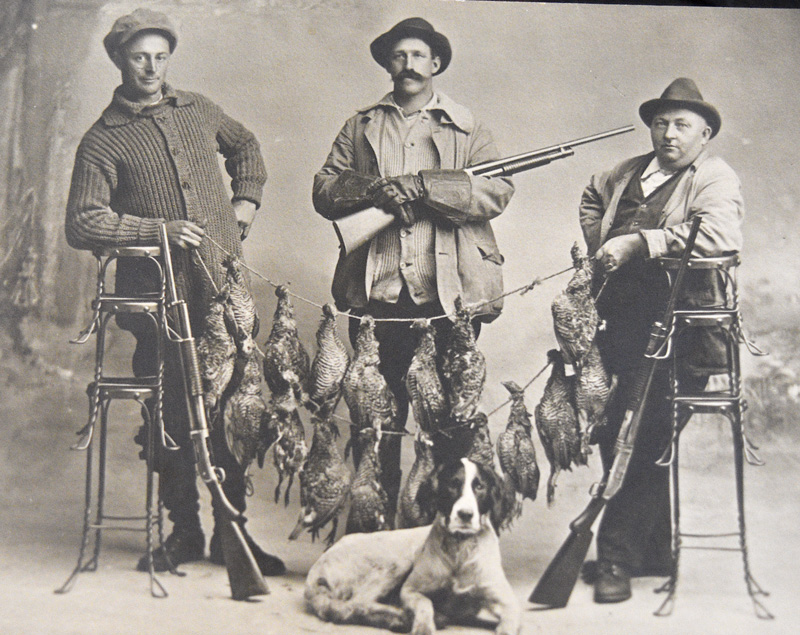Hard-working farmers in the late 19th Century (late 1800s) needed no extra exercise, but recreation was good for the mind and spirit as well as the body. Among adult pioneer men, hunting, target shooting and bowling were among popular pursuits.
Bowling, in the pioneer era, was an outdoor activity. The alley was shorter than in later indoor facilities. There were nine pins, instead of the 10 in the indoor era. The pin at the center was slightly different and was called the king pin. The object was to knock down eight pins, all except the king pin. That feat was called a ringer, which earned the bowler 10 bonus points.
The balls were rolled on the ground, which was carefully raked with a garden rake. At the other end was a wooden frame, level with the ground, on which stood the pins. There was a return trough, made of fence boards and elevated enough on one end to return the balls.
It was a team competition. At the beginning, teams were chosen, designated during play with either a red playing card or a black playing card in each player’s hatband. Bowling balls were fashioned from butts or stumps of white oak. There were no finger holes. Locally around Hokah, a cabinet maker, who had learned the trade in his native European homeland, made bowling balls and pins on his turning lathe. William J. Langen (1969-1960) remembered his father taking a white oak stump to have it made into a bowling ball.
In those days, no bowling ball rolled into a gutter, but Langen recalls one ball that rolled over the bank and disappeared into the Root River.
In the summer of 1880, a neighboring carpenter made a bowling alley on a level part of his backyard. It took about a half day to construct the runway, frame and trough. Several young married men, including William’s father, formed a bowling club. Being the oldest offspring among the membership, 11-year-old William was hired as the pin setter. The group played there nearly every Sunday afternoon with William earning 25 cents (equivalent to $7 purchasing power in 2024). Sometimes, their wives came along, but bowling was not yet a coed activity.
“They played each time for an eighth of beer,” recalled young William, “and everyone chipped in to help pay for it. …Total expense for an afternoon of bowling was $1.05 (purchasing power of about $28 in 2024), and there was plenty of beer for everyone. They enjoyed themselves very much, although I never saw anyone drunk, but oh, the shouting when someone made a ringer.”
In addition to hunting with firearms, pioneer-era men also enjoyed target shooting. This did not include older men who owned only muzzle loaders, which were too heavy and took too long to load. But after the .22 Long Rifles were introduced around 1887, target shooting became immensely popular. A box of 100 cartridges cost 25 cents.
Langen recalled his dad owning a steel target, handmade by a gunsmith. It was one foot in diameter with six rings cut into it. The center hole was the size of a quarter. When this bulls-eye was hit, a bell rang. Slaked lime was used to “whitewash” the target following each round. If a standard target was not available, a penny or other small item might suffice.
As a young teenager, William got in on the activity, too. Sometimes, the prize consisted of cartridges with the best shooter receiving two cartridges from the last-place shooter and the second-best shooter receiving one cartridge from the next-to-last shooter. Sometimes, the older men shot for money, building up a fund to buy beer.
However, there was one older fellow, John Hoffman, who lived on the lower Brownsville Road who could demonstrate considerable skill with the more primitive muzzle loader. About 1877, 8-year-old William witnessed Hoffman shooting a coffee cup out of a man’s extended hand. Then, the same man held in front of himself a spade with the blade above his head. When Hoffman fired at the blade, the impact nearly knocked the man off his feet.
A good hunting dog was invaluable. Langen said his father, an avid hunter, on his way home to southeast Minnesota from the Civil War (1861-1865), purchased a “pup hound” in St. Paul. This new four-legged denizen of Houston County turned out to be a superb hunting partner – easy to train. Once, father and hound returned after only two hours with nine pheasants. The dog was also adept with ducks, going right into the lake to retrieve the kill.
The hound from Hokah lived to hunt. One day, his owner opted to hunt alone and locked his usual partner in the barn. When the dog figured out what was happening, he jumped through the window, breaking the glass. The end of the story was not told, but it is likely the pooch had earned yet another hunting trip.
The dog did have one glaring fault. Anything edible was suitable for snatching. After a ferryboat trip with his owner to La Crosse, he helped himself to a piece of meat in a butcher shop. Sometime later, he dog-paddled across the Mississippi River, located the same shop and made off with baloney. The meat merchant recalled the previous visit and recognized the repeat meat snatcher. Langen’s father would settle up later.
Even after more modern hunting equipment became available, Langen remembered the men’s most cherished achievement was shooting a deer or bear with a bow and arrow. Naturally, the next generation of men, boys like William, became enamored with the bow and arrow as well. Hickory was used for the bows and oak for the arrows. In the area, there were still Native Americans, who although no longer relied on the bow and arrow for hunting as they once had, still had a sporting interest.
As a lad, William was gifted a bow and two arrows by a good neighbor, a Winnebago man named White Water. Those gifts were lifelong prized possessions.
Source: Just For Old Times Sake; History of Early Days of Hokah, Minn. by W. J. Langen (1869-1960), proprietor of Log Cabin Museum. The book celebrated the Hokah centennial (1849-1949).

Photo courtesy of the Houston County Historical Society


Leave a Reply